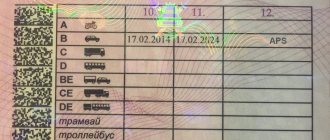What does the document look like?
The front side of the license, which gives the opportunity to drive a car with an automatic and manual transmission, is completely identical. The differences can only be seen from the reverse side. The “AT” mark should be located in the lower left corner when learning to drive a car with an automatic transmission.
This measure allowed students of driving schools to have more comfortable conditions when taking exams, because they no longer need to understand the structure of a manual transmission. But such a measure is still a significant limitation in the resulting category, because now the driver cannot drive a car with a manual transmission.
Which is better to learn: manual or automatic?
As a rule, in the CIS, the vast majority of driving schools just a few years ago offered only one option - learning to drive cars with a manual transmission. The exam also had to be taken only in a car with a manual transmission.
However, today the situation has changed somewhat, that is, there is a choice of transmission type. Naturally, many people wonder whether it is better to learn with a manual or an automatic. Moreover, you can even get a license for an automatic transmission, which excludes the possibility of using a car with a manual transmission. Let's figure it out.
- First of all, from the very beginning you need to separately take into account your own goals and objectives, as well as the characteristics of driving and operating cars equipped with automatic and manual transmissions.
At the initial stage, training in all driving schools is carried out the same way, regardless of the transmission of the car in which the driving tests will be taken. However, in the future, the car enthusiast has a choice: what is the best option: manual or automatic.
Some prefer an automatic transmission, believing that such a gearbox does not require unnecessary movements and manipulations, and will also make it easier to control the speed limit and the situation on the road. Others choose mechanics, believing that it will help them better feel the car’s behavior on the road while driving, when accelerating or braking.
Taking into account the fact that today it is possible to take driving lessons both on cars with a manual transmission and on cars with an automatic transmission, you need to pay attention to a number of features.
- First of all, it is important to understand that if you give preference to cars with automatic transmission, you can take the driving test in cars with automatic transmission. Accordingly, drivers who bet on cars with manual transmission will need to pass a driving test on cars with manual transmission.
Moreover, after passing the manual transmission exam, there are no further restrictions or prohibitions on operating a car with any type of gearbox (manual, automatic, CVT, robot). This means that the driver will be able to fully realize himself behind the wheel, actively use various types of transport, open new categories, etc.
If we talk about an automatic transmission, such a gearbox attracts beginners. The reason is that it is much easier to pass driving on it, however, a license with a note that only vehicles with an automatic transmission are allowed to drive also imposes certain restrictions on the owner.
This means that if in the future there is a need to switch to a car with a manual transmission, difficulties will arise (the driver’s license needs to be changed). Moreover, as practice shows, it is very easy to switch from a manual to an automatic, but after an automatic, changing to a manual can be a real problem.
The fact is that driving a manual transmission requires the driver not only to have a general understanding, but also to develop certain skills, which only over time reach full automaticity (as a rule, the driver gains sufficient experience only after driving about 30-50 thousand .km in city-highway modes). Also, a manual transmission immediately gives full control over the vehicle, the driver “feels” the car, and it is easier to overcome various problem areas on the road (icy conditions, off-road conditions).
Below, for beginners, are some features of driving a car equipped with an automatic and manual transmission. Let's start with the automatic transmission:
- The car starts moving. You need to start the car in “P” (parking) mode. After turning the key in the ignition and starting the engine, you need to depress the brake pedal, move the selector from position “P” to position “D” - forward movement or “R” (reverse, reverse). After removing your foot from the brake pedal, you need to smoothly press the gas pedal to accelerate the car.
- Towing a car with an automatic transmission. To ensure that the wheels rotate freely and are not connected to the engine, the selector is switched to the “N” (neutral) position. At the same time, it is strongly not recommended to tow a car with an automatic transmission when the engine is not running.
- The car is moving in first gear. When the vehicle speed is below 15 km/h (for example, difficult road conditions), the selector position should be on o (the ability to drive only in first gear).
- Driving at low speeds.
If the automatic transmission allows you to limit the driving speed with lower gears, then on steep climbs, when the speed limit of the car is low, use the “2, L2” selector mode. We also recommend reading the article about what automatic transmission designations exist. From this article you will learn about automatic transmission modes, as well as what the numbers and letters of the automatic transmission mean, when to use one or another automatic transmission mode, etc.
Features of driving a car equipped with a manual transmission:
- The car starts moving. Before starting the engine, the gearshift lever must be in neutral. After starting the engine, pressing the clutch pedal, you need to engage first gear and, smoothly releasing the clutch pedal until the car starts, synchronously press the gas pedal (the clutch pedal is smoothly released completely after the car starts moving).
- The movement of a car on a descent. Before descending, you must switch to a gear lower than the one in which the car was moving before the descent (the speed should not be higher than the one in which the car was moving during the ascent).
- The movement is on the rise. When lifting the car, it is necessary to depress the clutch pedal all the way and synchronously engage the required lower gear (taking into account the speed and loads). After this, while pressing the gas pedal, you must simultaneously smoothly release the clutch pedal.
- Reverse movement of the car. First of all, you need to depress the clutch pedal and engage reverse gear. If the car is parked on a slope or rolling, reverse gear should only be engaged after the vehicle has come to a complete stop. Smoothly releasing the clutch, you need to work the gas pedal a little so that the car moves smoothly and without jerking, while making sure that there are no obstacles in the direction of the car’s movement.
- Smooth stop. Turn on the right turn, while pressing against the right extreme side of the roadway or shoulder, release the gas and squeeze the clutch. Move the gear lever to the neutral position and smoothly depress the brake pedal with your right foot until the car comes to a complete stop.
- Emergency braking. During this type of braking, the clutch and brake pedals are pressed sharply and simultaneously, and the gearbox shift lever is moved to the neutral position.
Features and capabilities
To be able to drive a car with a manual transmission, the driver will have to retrain and retake the exams. This is because driving with manual controls is much more difficult. The driver will need to understand using the clutch to change speed, learn the gear ratio, and also become comfortable with the need to balance the speed of the vehicle with the engine speed.
Understanding engine operating modes is not easy for everyone. If a driver first learns to drive a car with a manual transmission, then he can easily drive a car with an automatic transmission. The issued licenses are considered universal, since re-examination is not required in this case.
What symbol represents the machine?
The back of the driver's license consists of a table. It lists all groups of vehicles existing in Russia. There are 7 main types of vehicles.
There are also subcategories. There are only 4 of them. Opposite the group for which the cadet is training, the start date of the driver’s license is placed, then the expiration date and a mark.
Read
What is the difference between a CVT and an automatic: how to find out and which is more reliable
This symbol is represented by two capital letters "AT". The machine is placed only opposite category “B” in column 14. It is located at the bottom of the document under the category table.
| Category | License date (12) | Rights expiration date (11) | Restrictions (12) |
| A | – | – | – |
| A1 | – | – | – |
| B | 15.09.2017 | 15.09.2027 | – |
| B1 | – | – | – |
| C | – | – | – |
| C1 | – | – | – |
14 AT
Having dealt with the differences between documents for a car with an automatic transmission and the place where the driver’s license indicates that the car owner has learned to drive a manual or automatic transmission, the reader will learn about the difficulties of driving a car with a manual transmission.
Categories and subcategories of rights
Now categories marked “automatic or manual” have been expanded with subcategories. There are main categories, which include: “A”, “B”, “C”, “D” or “M”. For driving a vehicle with a trailer, the license has a subcategory with the letter “E” at the end. The main 6 categories are now divided into 16 subcategories. For example, if group “A” allows you to travel on motorcycles, then “A1” only allows you to ride light motorcycles or mopeds with an engine of no more than 125 cc.
IMPORTANT !!! The same story with category “B”. Without adding a unit, vehicles up to 3.5 tons can be controlled. There can be no more than 8 passenger seats. Category “B1” will provide the ability to drive tricycles and quads. Trucks can be driven only if they have category “C”, but if category “C1” is open, then there are restrictions due to which the driver will not be able to drive a vehicle over 7.5 tons.
In general, a unit next to the letter identifier in a category indicates the presence of various types of restrictions. For example, having the “D1” category open, it will be possible to transport passengers by minibuses, the number of seats in which does not exceed 16. Drivers with categories “BE”, “CE”, “C1E”, “D1” or “DE” will be able to drive vehicles of the corresponding category with a trailer whose weight does not exceed 3.5 tons. Mopeds and scooters with an engine capacity of up to 50cc can be driven with the “M” category.
To drive a tram, you will need the category “Tm”, and for a trolleybus – “Tb”. All these categories will be displayed in the rights, but the admission mark will only appear in open positions.
Cost of education
Although training for a manual transmission is much more difficult, the cost of training is much lower. The difference in cost is due to the low cost of such models and cheaper maintenance.
Some schools have the same price for an automatic transmission and a manual one, and the cost of training in a driving school will directly depend on the federal significance of the city. In Moscow or St. Petersburg, driving courses will cost much more than in smaller cities. Each organization providing training services for future drivers calculates the cost of classes in accordance with the adopted regulations. Some companies include the price of lubricants in the cost of training, while others charge for them separately. An important aspect in determining the cost of training is the quality and model of cars provided to students to master the art of driving.
Some drivers have difficulty learning the material taught or need more hours of driving instruction. In this case, they have the opportunity to order additional classes.
What is the difference between training for a manual and automatic driving license?
Driving with a manual transmission requires increased care:
- while driving;
- at the traffic light;
- when performing maneuvers on turns, turns or in other cases.
It is necessary to be able to react in a timely manner when changing gears, first pressing the clutch pedal and then the gas. The driver must remember that first gear is engaged, then second, third, etc. There is no need to do this on an automatic transmission. The computer will decide everything for the driver.
Attention! Driving with a manual transmission requires good reaction, concentration and refined movements. Any confusion may lead to an accident.
Otherwise, training for automatic and manual transmission licenses is the same.
- Instructors teach traffic rules. Students study them and remember them. They take short tests on the material covered.
- They study the design of a vehicle with automatic and manual transmission.
- They are told about road accidents and what to do in the event of a road accident.
- The ability to provide first aid to a person involved in a traffic accident is studied.
- After the theoretical rules are memorized, the instructor begins training future drivers at the race track.
- And only after this, the driver, in the presence of an instructor, can go to a populated area and undergo city driving training.
Read
Which is better and more reliable, CVT or automatic?
If a student wants to study for category “C”, then he first undergoes training for “B”, and only then receives admission to “C”.
Differences in exams
The theory of traffic rules remains unchanged, so this exam will be held under the same conditions for all groups. Usually, before starting training, the future driver can choose a car model and type of gearbox, if the driving school has such an opportunity. In small towns, people get a license with a manual transmission much more often, because the range of cars for training there rarely pleases anyone.
The requirements for passing the practical part change quite often, so it is best to find out about them before starting training. The driving test procedure for any type of training is not much different, but there may be some nuances that are best known in advance.
What a future driver needs to know
When learning to use an automatic transmission, you should not drive with a manual transmission. If such a motorist is stopped by representatives of the State Traffic Inspectorate, such an offense will be equated to driving without a license. In this case, the car will be towed to the impound area, and the driver will face a hefty fine and a lot of headaches in freeing his vehicle.
A driver who has never driven before will find it much easier to learn in a car with an automatic transmission than in a car with a manual transmission. Performing complex shifting exercises will not cause him a lot of discomfort. The car will gently obey the driver, without upsetting him with jerks or sudden engine shutdown. This is a huge advantage for beginners. But if such a driver has a car with a manual transmission in his garage, he needs to make a serious decision on the type of training or changing the car. Passing the test when driving with an automatic transmission is quite simplified, because there are no special requirements for the driver.
ATTENTION !!! When training is carried out on a car with a manual transmission, the driver will be able to obtain a universal license that will give him the opportunity to drive any vehicle of this category.
The acquired skills will be useful and applicable in practice. Thanks to this, the car enthusiast will be able to choose his driving style without feeling the limitations that constrain him. Life situations can sometimes change. The driver may have the opportunity to drive only a car with a manual transmission, so you need to be prepared for any turns. Given the same cost of training, it is preferable to choose a mechanical gearbox.
The choice must be made by the driver before the start of training, since in the future he will have to master a more complex option, using additional training hours for this. Experienced drivers recommend learning to drive a car with a manual transmission, but everyone makes the choice for themselves.
The procedure for obtaining the right to an automatic and manual transmission
Attention! Any citizen of the Russian Federation who is 16 years old at the time the license is issued can drive mopeds and motorcycles. Categories A, B, C open after reaching adulthood. A group of licenses to drive a car with a trailer, trucks, buses is issued to students who have turned 21 years old. An educational institution will not accept courses if the student has not reached the required age to obtain a tertiary education in one of the groups.
To become a full-fledged owner of a driver’s license for a car with an automatic transmission or manual transmission, a cadet must:
- learn theoretical information;
- undergo practical training with an instructor;
- pass a medical examination;
- bring the documents that are required;
- successfully pass exams;
- obtain a driving license.
Documents you will need:
- application for the issuance of rights;
- passport identification;
- certificate of registration at the place of residence;
- medical certificate U-89;
- certificate of completion of training in driving programs;
- photo 3x4;
- receipt of payment for exams.
Attention! The cost of a temporary driving permit is 500 rubles, and the state fee for issuing a license costs 2,000 rubles.
The license to drive a vehicle with an automatic or manual transmission is issued directly to those who have completed training. All information about this person is entered into a computer and stored electronically on the traffic police servers.
Cars for training cadets with disabilities are equipped with special equipment. This is done to speed up the production of rights.
Read
Diagram and device of planetary transmission of automatic transmission
To obtain a medical certificate, you must visit the following doctors:
- otolaryngologist;
- ophthalmologist. If the future driver has a slight visual impairment, then this will definitely appear on the driver’s license. It, like the symbol “AT”, will be recorded in the fourteenth line. The visually impaired driver symbol is displayed as GCL;
- neurologist;
- do an encephalography;
- donate blood and urine for analysis;
- expert in narcology. If the doctor discovers that the future driver uses even light drugs, then he may be suspended from training for any category of license, not just automatic or manual;
- therapist. He gives an opinion on the degree of suitability to study for a license.
The theoretical part lasts 136 hours, the practical part – 56 hours for passenger vehicles and light-duty trucks.
If the future driver studied independently and wants to take the exams, then he needs to submit an application electronically on the State Services website or to the traffic police. If a cadet nevertheless decides to study at a vehicle driving school, and he does not have enough hours to gain solid skills, then he can turn to the instructors for additional time.











